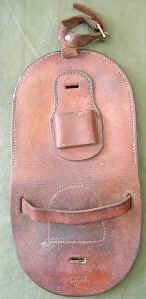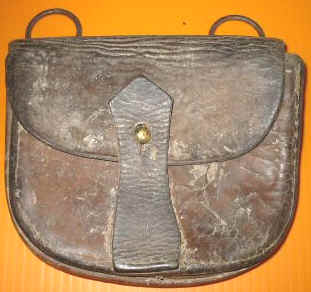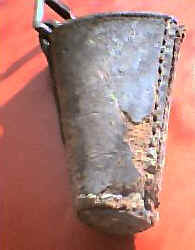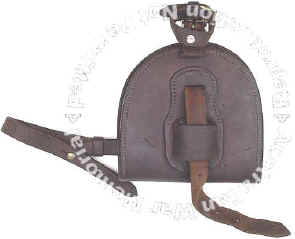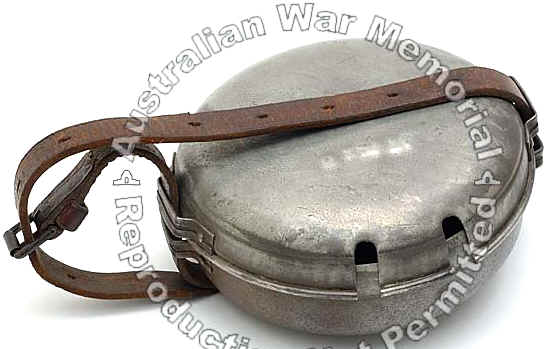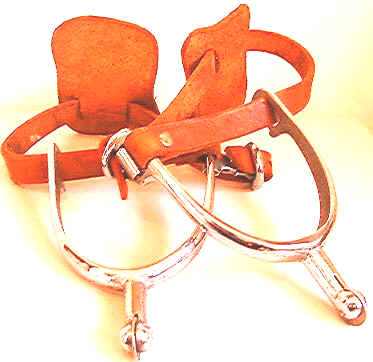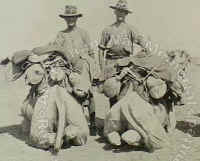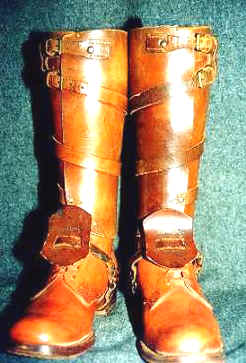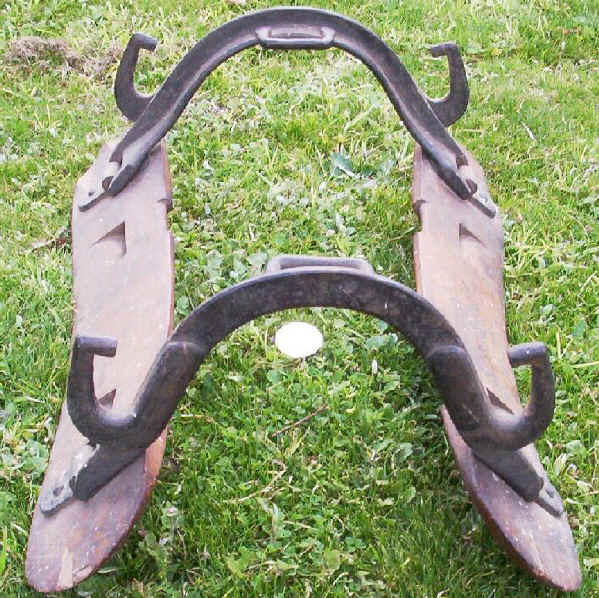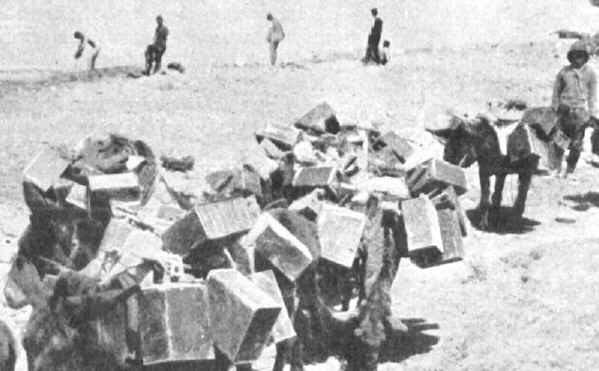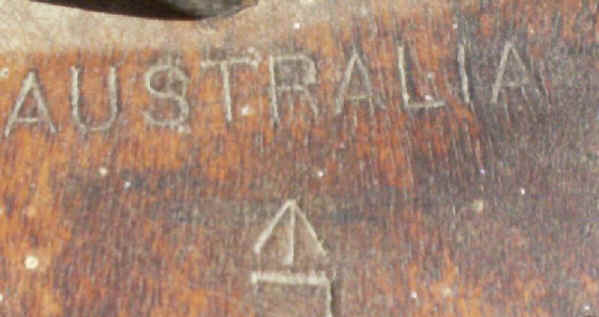 |
|
|||
|
|
||||
|
Light Horse Equipment |
|
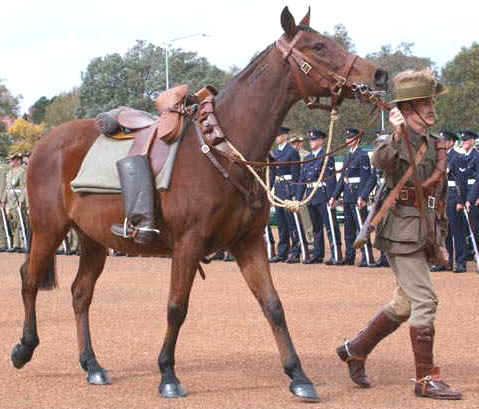 |
This is a member of Australia's Federation Guard in 2002 It is the most highly trained ceremonial Unit in the ADF. Great care is taken to make the sure that they turn out in historically accurate order. Apart from the reversed boots to indicate death of a warrior this horse and rider are kitted out as they would have been in 1914/18. |
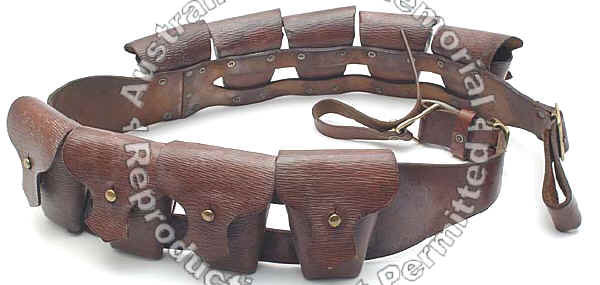 |
| Nine pouch, brown leather ammunition bandolier. This type of bandolier was used by Australian Light Horse units. The horse carried one around its neck and the rider one across the shoulder. The leather band supporting the ammunition pouches is cut in a curve and is in two pieces joined by three steel rivets. Each side has a cut out strip in the centre where the pouches are attached top and bottom by steel and copper rivets. There are four pouches on one side and five on the other. Each pouch has a flap fastened by a brass stud. The length of the bandolier can be adjusted by brass buckles at either end. One end can be further adjusted by a narrow leather strap with a brass stud that is attached to the bandolier on a brass triangle. Bandolier is stamped with manufacturer's details 'T. THOMASSON & Co WORCESTER 1916'. |
 |
Drawing
by George Lambert; saddle, surcingle; Australian Light Horse units; 1912
Universal Pattern (UP) saddle, with rolled blanket and feed bag over
pommel, surcingle, rolled greatcoat and groundsheet, mess tin, fodder
bag and attached to cantel of saddle.
AWM image and text. |
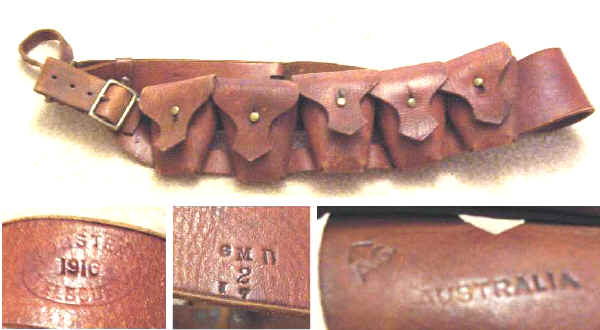 |
|
|
Light horse bandolier, for details see above. |
|
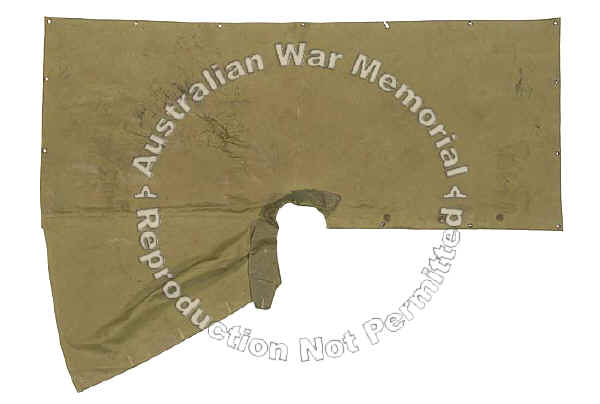 |
|
| Gas cape/groundsheet. Rubberised Cotton; Brass; Plastic; Khaki rubberised cotton gas cape, with stand and fall collar, brown plastic buttons and brass riveted holes along four sides. The capes could also be used as a ground sheet or a rain shelter. The cape is secured to the saddle wallets by two leather straps, each with a split double buckle attachment. Most Light Horsemen carried a standard rectangular groundsheet. It was folded and strapped over the saddle wallets. Towards the end of the First World War rubberised gas capes became more widely available and were often substituted for the standard groundsheet, as they could be worn as a protective cape as well. The pattern for the gas cape did not alter until it ceased to be issued in the 1960s. | |
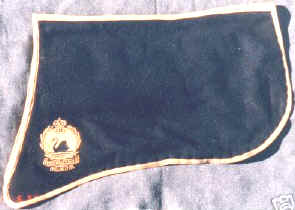 |
|
|
Ceremonial saddle blanket of the 10th Light Horse |
Early version of combined horse-shoe carrier & sword scabbard holder. Dated 1911. |
|
|
Australian Light Horse leather saddle pouch dated 1902 |
|
|
 |
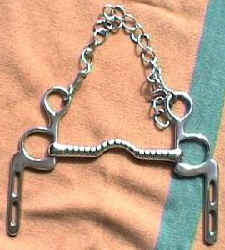 |
| Lance stirrup of the Light Horse | Water canteen ALH, WW1 | Horse's bit from Light Horse |
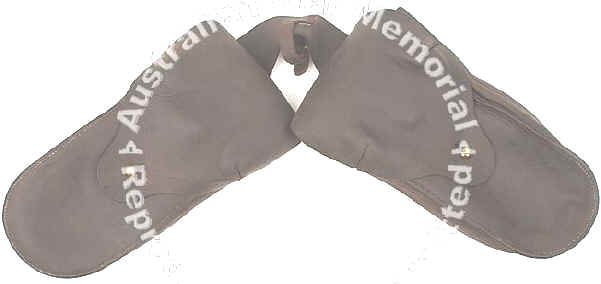 |
| Pair of standard issue brown leather saddle wallets for attachment to the pommel of the Universal Pattern 1912 steel arch saddle. The wallets are linked together by a sewn leather strap. They have shaped covering flaps secured by brass studs. |
|
|
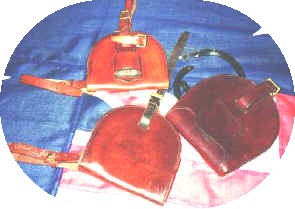
photo: Rob Thomas |
| All light horsemen carried a horseshoe carrier (5 styles were used) containing spare nails and two horseshoes as standard issue, so that horses could be re-shod immediately if they accidentally cast a shoe. Brown leather horseshoe carrier for attachment to the 1912 Pattern UP saddle, with steadying straps for attachment to the saddle tree and 'V' attachment above girth. The outside of the case also has a strap and frog attachment to carry a sword. The inside of the case contains two horseshoes, one fore and one hind, and a small pouch with four spare horseshoe nails. Strap for attachment to the saddle tree only is stamped 'Weekes Sydney 1911'. | |
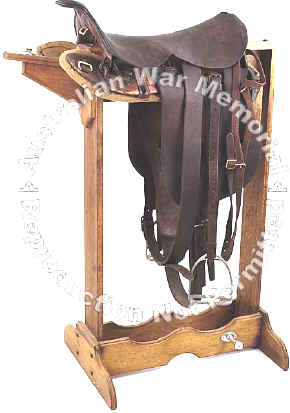 |
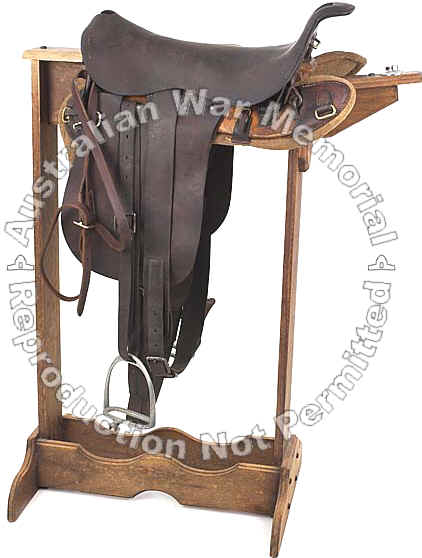 |
| Standard issue saddle used by British and Australian mounted, artillery and transport units from 1912 until 1941. 1912 Universal Pattern steel arch brown leather saddle complete with surcingle, double buckle folded leather girth, stirrup leathers, two bar steel stirrup irons stamped 'H.V. McKAY 1915 (broad arrow) STEEL', a beechwood tree made in England and stamped 'GHO 1915 3', and leather and khaki felt numnah panels. The 'V' attachment is stamped 'C.G.H.F. (broad arrow) A.F.A. 29', indicating that leather components of the saddle were made by the Commonwealth Government Harness Factory in 1929. | |
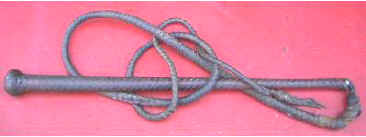 |
Stock whip as used by the men who drove the horse teams for artillery and cargo transport. |
 |
Light Horse tethering peg, hobble and rope. Octagonal wooden tethering peg is reinforced with steel at the tip and around the head. The upper part of the peg has been drilled through and has a loop of hemp rope. The rope from the hobble attaches to the peg loop when the horse is tethered. Single hobble is made from three layers of brown leather secured by steel rivets. The hobble fastens with interlocked steel rings. |
| A further ring on the hobble has a length of jute rope attached, with whipped ends. The hobble rope can be attached to another tethering rope, REL30045.003, if more length is needed. The hobble, rope and peg are secured to the saddle by a leather strap with a steel buckle to a dee on the near side of the saddle, behind the horse shoe carrier. The strap is stamped with a Second World War Victorian service number 'VX50238'. |
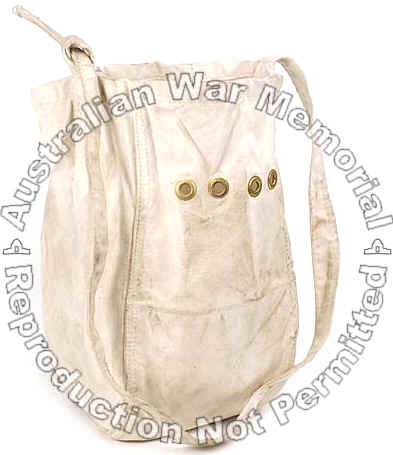 |
Cream
canvas feed bag for a horse, designed to be
attached to the saddle to carry feed and then to be placed on the
horse's head as a nosebag so that it can eat.
The bag has a rectangular shape and the bottom is reinforced by a second layer of canvas. Four large brass reinforced riveted holes have been placed horizontally across the front of the bag, approximately 95mm from the top edge of the bag, to provide the horse with ventilation while it is eating. A canvas strap is attached to the left side of the bag and threads through a canvas loop on the right side. It can be tied and adjusted to a suitable length. |
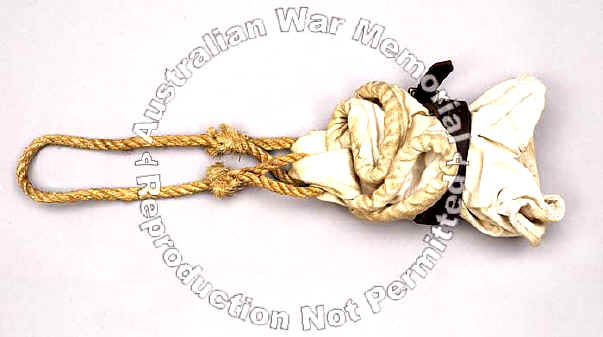 |
|
 |
Cream canvas water bucket
with a jute rope carrying handle attached to two heavy canvas loops
machined to each side of the bucket. (Above,
folded, left, ready to use)
The top edge of the bucket has a sleeve threaded through with rope for reinforcement and to steady the bucket when it is full of water. The body of the bucket is secured for attachment to the saddle, when empty, by a brown leather strap with a brass buckle, passed several times around the bucket. |
|
|
|
| Round steel mounted service mess tin with fold out handle and lid. Lid is stamped on the inside with the service number 'WX3074'. The tin and lid are secured by a brown leather strap and buckle which attaches to the saddle. The strap is stamped with the service number 'SX5848'. Standard issue mounted service mess tin and strap used by Australia during the First World War and until mounted services were discontinued at the end of 1942. This tin and strap are marked with Second World War service numbers. | |
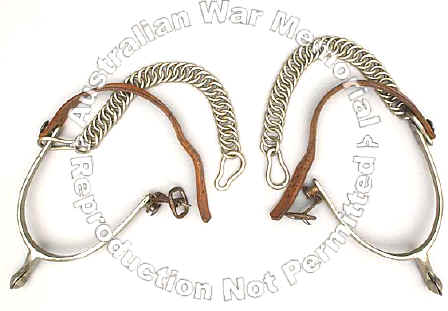
|
Pair
of private purchase spurs with British sixpence coins for rowells.
The spurs each have a single leather boot strap connecting to a buckle, and a length of chain, to be worn under the instep, attached at each end with a sliding clip. The sixpence coins are dated 1915 and 1916, and the inside of each spur is stamped 'SOLID NICKEL'. Pair of spurs from New Zealand Mounted Rifles. Again the rowells have been replaced with the more humane sixpence coins. Note the butterflies form part of the spur harness. |
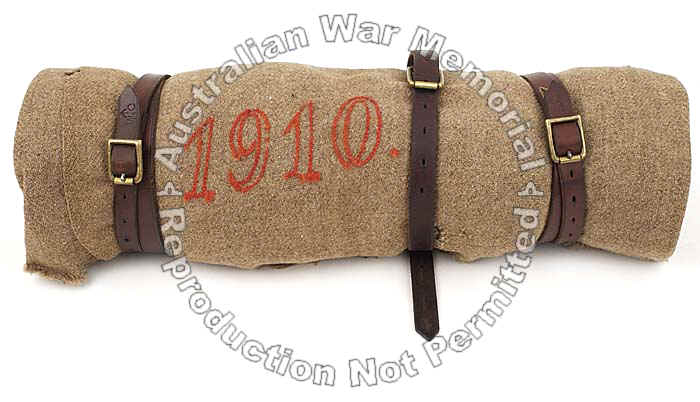 |
| Coarse weave light brown woollen blanket. The sides have a selvedge but each end is unfinished. The blanket is folded lengthwise into four even panels and then tightly rolled to fit behind the cantle of the saddle. It is secured to the cantle by a single brown leather strap with a brass buckle, stamped in the leather 'WM OVERTON LTD WALSALL 1916'. The length of this strap is 89cm. The blanket is further secured by leather straps at each end, one, 98 cm long, stamped 'C.DORNEY PERTH 1915 W (broad arrow) C'; the other 95 cm long and stamped 'H.G.R. 1916'. The top of the blank roll has been hand embroidered in red wool chainstitch '1910'. |
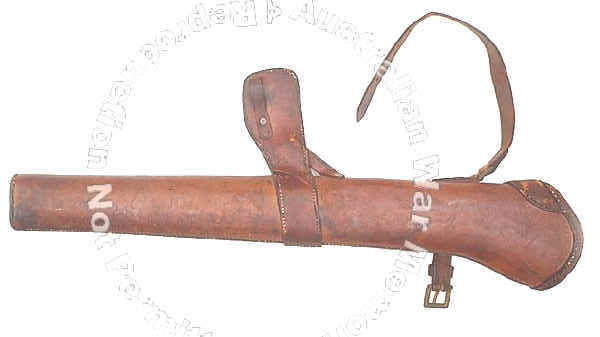 |
| A Light Horse WW1 issue rifle bucket, leather. |
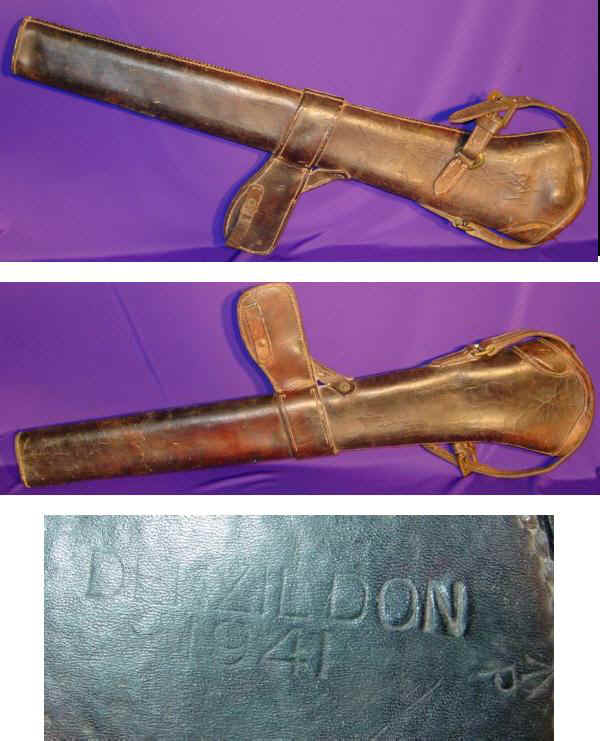 |
|
1941 issue Australian Light horse rifle bucket. |
| The heliograph was not strictly speaking a Light Horse only piece of equipment but as the infantry were either at Gallipoli or in France/Flanders where such equipment was not needed or used it meant that the Lt Horse were the only ones to make significant use of them. |
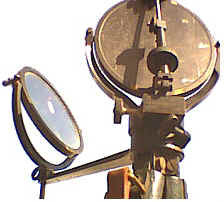 |
Heliograph, used by
signallers, to send reflected sunlight in flashes of Morse Code, over a
considerable distance.
The heliograph is a mirror set on a metal base which allows the mirror to be positioned on such a way as to reflect sunlight to a particular site. When operating over a long distance a telescope is used to assist in receiving the signals. The mirror can then be moved, by the use of a key to send flashes of light, therefore enabling the user to send a series of dots and dashes, in a code. |
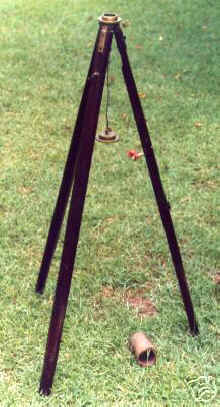 |
The code used is known as
Morse Code. The mirror and metal base are attached to a heavy tripod.
This tripod has to be solid enough to hold the heliograph firmly in
position, because moving the mirror slightly will take it off the aimed
position.
Shown here it is prepared to operate with the sunlight behind it. Another mirror is set in a position to reflect sunlight onto the operating mirror. Image and text of heliograph from Grants Militaria <<< Heliograph stand. This is a Tripod for a Daylight Signal Lamp or Heliograph. It is made from wood and brass and is marked "Stand lamp or Helio A, Mk III, 202216" on one brass section and "London 1916" on another. There is a brass hook under the assembly for a plum-bob for point positioning or C.O.G.. It is also marked with the early Defence Department mark of the Large letter "D" with a broad arrow inside same.This is on the brass cap and on one of the wooden legs. There is a leather cover for the legs but not other straps. Stand is approximately 3 feet/1metre high. |
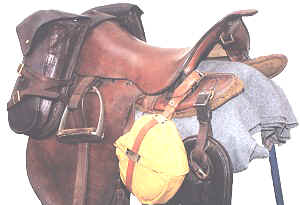 |
|
| In
1912 the British Army had developed a saddle which required no further
modifications. The saddle of the pattern 1912, was also known as the
swivel tree saddle. The wooden boards on which this saddle was based,
attached to the frame of the saddle by some simple hinges, this is known
as the 'tree' of the saddle. This allowed this saddle to fit a number of
different sized horses. Before the advent of this base, the saddle had
to be chosen according to the size of each horse from 3 sizes available.
During WW1 the Australian Army made a great deal of use of horse mounted troops, and used a large number of mounted infantry. Before the 1912 pattern saddle there was the pattern of 1902, a very good design but with a fixed tree (3 sizes). Both these saddles were used throughout the war. The saddle sat on the horses back, after a blanket was first put down (with the Australian Light Horse, in 1916, two blankets were instructed to be used, one the heavy horse blanket and the other a four folded lighter bedding blanket). The saddle was held in position on the horse with a girth strap. Various pieces of equipment were strapped to the saddle. Leather saddle wallets went to the front of the saddle and a mess tin, horse shoe case (which was also a sword frog for the cavalry - Australians were issued a sword in 1918), and a feed bag. The horse shoe carrier was issued with each soldier with a saddle. Other personal equipment found its way onto the saddle. According to an ex-light horseman, once the other blanket, greatcoat and other equipment was piled up to the front and rear of the saddle seat, it was impossible to fall off. image and text from Grants Militaria |
Palestine. 1918. Two soldiers, possibly members of the 5th Light Horse Brigade, stand beside their camels which are fully laden with their kit. The back view of the animals shows the full assortment of equipment including sleeping and cooking gear. (Donor I. Smith) |
|
|
|
Pack saddle for mules and donkeys. |
|
|
|
|
|
Fully loaded pack animals. |
|
|
|
This saddle was made in Australia for the military (note the Broadarrow) |
